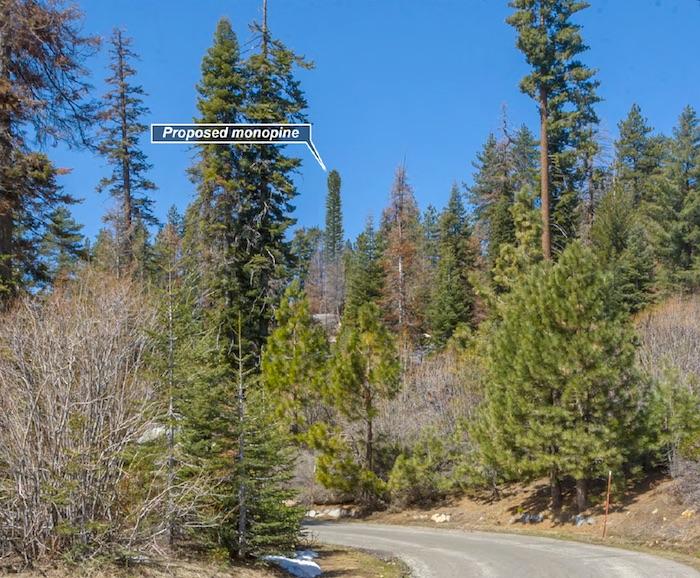
Verizon Wireless wants to disguise a cellphone tower as a pine tree at Sequoia National Park. The perspective of this shot makes it difficult to determine how high above the rest of the forest the tower would rise/NPS, Verizon Wireless
If a scrawny looking pine tree towered above other pines near Wuksachi Lodge in Sequoia National Park, would you figure out that it was a cellphone tower? And would you then care that your backcountry hikes might be interrupted by someone chatting loudly on their phone or streaming Drake?
Those are questions the National Park Service is seeking your thoughts on as they consider a proposal from Verizon Wireless to disguise a cellphone tower as a pine tree near the lodge.
The ubiquitous nature of cellphones these days brings more and more demands for cell signals wherever one roams, even if they might be in a forest of giant sequoias. That said, just 29 people took time to comment on the proposal earlier this year, though 17 of those expressed concerns that widespread cellphone coverage "reduces the contrast between wilderness and other lands, and negatively impacts wilderness character."
Against that position, though, are the views of employees in the park who feel isolated without cellphone coverage, and the safety aspect of being able to quickly contact help.
A total of 203 health and safety incidences were recorded in the Lodgepole / Wuksachi area in 2017, including search and rescue calls (20), emergency service calls (146), motor vehicle collisions (33), and fatalities (4). -- National Park Service
Verizon Wireless is proposing to construct a 138-foot cellular tower west of Wuksachi Village to achieve a coverage objective that includes a portion of the Generals Highway, the Wuksachi Village, Lodgepole, and Wolverton areas. Antennas would be directed, as much as possible, away from the wilderness, the park's environmental assessment says.
Comments on the plan are being taken through November 26.
The proposed wireless communications facility would include the following components within a 40-foot by 40-foot area adjacent to two existing above-ground water storage tanks:
- A 138-foot tall tower with panel antennas and microwave dishes, potentially constructed to simulate a pine tree, mounted on a 4 to 5-foot diameter footer
- A covered 28-foot by 13-foot steel equipment platform
- A 500-gallon propane tank mounted on a concrete pad
An estimated 1,420 feet of buried electrical cable would be installed along the existing access road to connect the tower to an existing electrical transformer. Two 14-inch diameter fir trees would be removed from the facility site. A total of approximately 0.23 acres of land within the park would be affected by the project, including the trenched area adjacent to the access road (0.19 acres), and the communications facility (0.04 acres).



Comments
Best common sense answer!
This NOT a wilderness area. It is a PARK! Have a healthy 'fine/penalty' for cell phone use in the area. To help save lives, by providing cell phone use for emergencies is a valid application in todays world. It's like saying there's a doctor down the road but we can't get in touch with him/her because we MIGHT disturb someones privacy.
The tower itself isn't proposed for a wilderness area. In general permanent fixtures like this aren't generally allowed in fully designated wilderness areas, but there are exceptions such as ranger cabins, outhouses, and even exceptions built into the enabling legislation, such as dams and maintenance roads.
However, the reach of a cellular tower's signal will enter a wilderness area. It's not illegal to use electronics in wilderness areas. It would still be problematic to prohibit the routine use of cellular communications on the basis that it would disturb others' solitude. It would be akin to making it illegal for hikers to talk to each other or illegal to sing around a campfire.
If this celltower is not inside designated park wilderness, then I am for it as long as it doesnt visually impair the experience and the company pays for the cost of camouflage.
First, I suspect you'll see fatalities--I've visited Sequoia multiple times, and peopel trying to use their phones on those roads will drive off the mountian.
Second, there have to be some truly wild places. If folks don't want experience wilderness, there are other parks where they can whip their phones ourt any time they want to. And the phhone-less oarks don't seem to be hurting for visitors. Leave SEKI alone.
For safety reasons I believe they should be allowed to put in the tower.
while I could see a need for communications in emergency situations, we all know the people will spend time in the park talking on or streaming their favorite tv show. Let's not forget what someone said a long time ago "Come to the woods for hear is rest" (John Muir).
I agree completely. There is no need for a cell tower. It can only disrupt the peace of the park